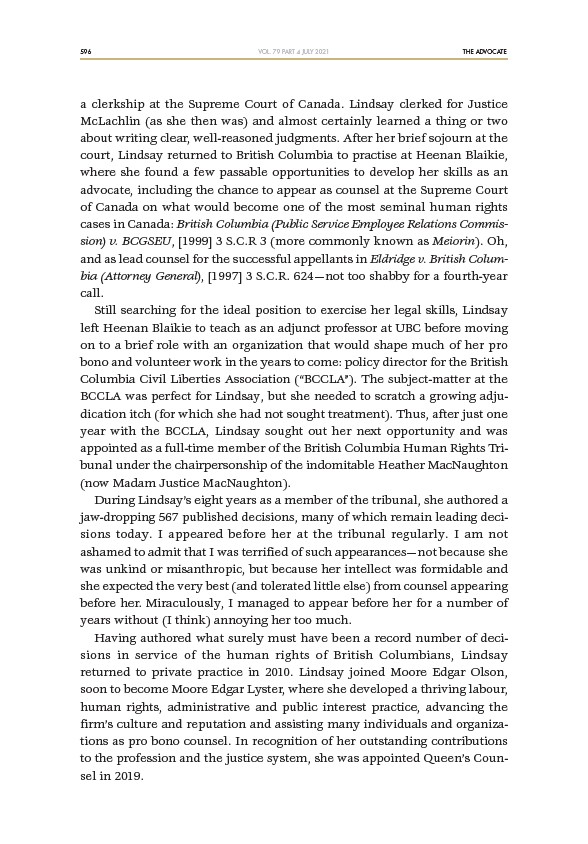
596 THE ADVOCATE
VOL. 79 PART 4 JULY 2021
a clerkship at the Supreme Court of Canada. Lindsay clerked for Justice
McLachlin (as she then was) and almost certainly learned a thing or two
about writing clear, well-reasoned judgments. After her brief sojourn at the
court, Lindsay returned to British Columbia to practise at Heenan Blaikie,
where she found a few passable opportunities to develop her skills as an
advocate, including the chance to appear as counsel at the Supreme Court
of Canada on what would become one of the most seminal human rights
cases in Canada: British Columbia (Public Service Employee Relations Commission)
v. BCGSEU, 1999 3 S.C.R 3 (more commonly known as Meiorin). Oh,
and as lead counsel for the successful appellants in Eldridge v. British Columbia
(Attorney General), 1997 3 S.C.R. 624—not too shabby for a fourth-year
call.
Still searching for the ideal position to exercise her legal skills, Lindsay
left Heenan Blaikie to teach as an adjunct professor at UBC before moving
on to a brief role with an organization that would shape much of her pro
bono and volunteer work in the years to come: policy director for the British
Columbia Civil Liberties Association (“BCCLA”). The subject-matter at the
BCCLA was perfect for Lindsay, but she needed to scratch a growing adjudication
itch (for which she had not sought treatment). Thus, after just one
year with the BCCLA, Lindsay sought out her next opportunity and was
appointed as a full-time member of the British Columbia Human Rights Tribunal
under the chairpersonship of the indomitable Heather MacNaughton
(now Madam Justice MacNaughton).
During Lindsay’s eight years as a member of the tribunal, she authored a
jaw-dropping 567 published decisions, many of which remain leading decisions
today. I appeared before her at the tribunal regularly. I am not
ashamed to admit that I was terrified of such appearances—not because she
was unkind or misanthropic, but because her intellect was formidable and
she expected the very best (and tolerated little else) from counsel appearing
before her. Miraculously, I managed to appear before her for a number of
years without (I think) annoying her too much.
Having authored what surely must have been a record number of decisions
in service of the human rights of British Columbians, Lindsay
returned to private practice in 2010. Lindsay joined Moore Edgar Olson,
soon to become Moore Edgar Lyster, where she developed a thriving labour,
human rights, administrative and public interest practice, advancing the
firm’s culture and reputation and assisting many individuals and organizations
as pro bono counsel. In recognition of her outstanding contributions
to the profession and the justice system, she was appointed Queen’s Counsel
in 2019.